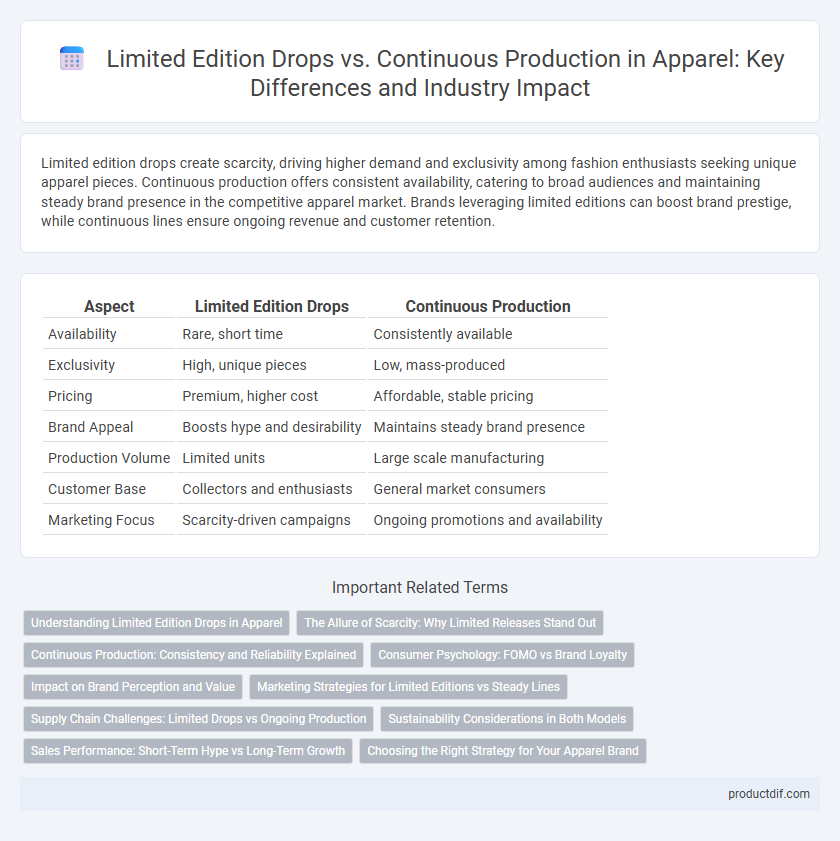Limited edition drops create scarcity, driving higher demand and exclusivity among fashion enthusiasts seeking unique apparel pieces. Continuous production offers consistent availability, catering to broad audiences and maintaining steady brand presence in the competitive apparel market. Brands leveraging limited editions can boost brand prestige, while continuous lines ensure ongoing revenue and customer retention.
Table of Comparison
| Aspect | Limited Edition Drops | Continuous Production |
|---|---|---|
| Availability | Rare, short time | Consistently available |
| Exclusivity | High, unique pieces | Low, mass-produced |
| Pricing | Premium, higher cost | Affordable, stable pricing |
| Brand Appeal | Boosts hype and desirability | Maintains steady brand presence |
| Production Volume | Limited units | Large scale manufacturing |
| Customer Base | Collectors and enthusiasts | General market consumers |
| Marketing Focus | Scarcity-driven campaigns | Ongoing promotions and availability |
Understanding Limited Edition Drops in Apparel
Limited edition drops in apparel create scarcity by releasing a restricted number of items, driving high consumer demand and enhancing brand exclusivity. These drops often feature unique designs or collaborations that appeal to trend-conscious customers seeking originality. Unlike continuous production, limited edition releases leverage urgency and limited availability to boost sales and engage communities through hype and anticipation.
The Allure of Scarcity: Why Limited Releases Stand Out
Limited edition drops harness the power of scarcity to create urgency and exclusivity, driving heightened consumer demand and perceived value in the apparel market. Unlike continuous production lines, these limited releases generate buzz and foster a sense of community among enthusiasts eager to own rare, unique pieces. This strategic rarity not only elevates brand prestige but also often results in higher resale values and long-term collector interest.
Continuous Production: Consistency and Reliability Explained
Continuous production in apparel ensures consistent availability of popular styles, enabling brands to meet ongoing consumer demand without disruption. This manufacturing approach leverages established supply chains and quality control processes, enhancing reliability and customer trust. Steady inventory flow supports brand loyalty and predictable revenue, positioning continuous production as a strategic choice for scalable growth.
Consumer Psychology: FOMO vs Brand Loyalty
Limited edition drops tap into consumer psychology by creating a sense of scarcity, triggering FOMO (fear of missing out) that drives urgent purchasing behavior and amplifies perceived value. Continuous production fosters brand loyalty by building consistent availability and trust, encouraging repeat purchases and long-term consumer relationships. Balancing limited edition exclusivity with reliable product access leverages both impulsive gratification and sustained commitment in apparel marketing strategies.
Impact on Brand Perception and Value
Limited edition drops create a sense of exclusivity and urgency, enhancing brand perception by positioning products as rare and highly desirable collectibles. Continuous production supports brand accessibility and consistency, but may dilute perceived value due to product abundance and reduced scarcity. Brands leveraging limited editions often experience heightened customer loyalty and premium pricing, reinforcing their market positioning as trendsetters and innovators.
Marketing Strategies for Limited Editions vs Steady Lines
Limited edition drops create urgency and exclusivity by leveraging scarcity marketing, driving immediate consumer demand and higher perceived value. Continuous production focuses on brand consistency and steady revenue through long-term customer loyalty and predictable inventory management. Marketing strategies for limited editions emphasize hype generation and social media buzz, while steady lines rely on durable brand identity and ongoing consumer engagement.
Supply Chain Challenges: Limited Drops vs Ongoing Production
Limited edition drops create supply chain challenges due to unpredictable demand spikes and compressed timelines, requiring agile inventory management and rapid distribution. Continuous production relies on stable, forecast-driven supply chains that prioritize efficiency, reducing the risk of stockouts and overproduction. Brands must balance flexibility for limited releases with the scalability of ongoing production to optimize supply chain performance.
Sustainability Considerations in Both Models
Limited edition drops reduce overproduction by creating scarcity, which minimizes unsold inventory and waste, aligning closely with sustainable fashion goals. Continuous production supports consistent availability but often leads to excess stock and higher resource consumption, challenging sustainability efforts. Brands adopting lifecycle assessments and eco-friendly materials in both models can balance market demand with environmental responsibility.
Sales Performance: Short-Term Hype vs Long-Term Growth
Limited edition drops generate intense short-term hype by creating scarcity, driving rapid sales spikes and heightened consumer urgency. Continuous production supports long-term growth through steady inventory availability, building brand loyalty and consistent revenue streams. Brands leveraging a hybrid approach maximize immediate sales impact while nurturing sustained market presence.
Choosing the Right Strategy for Your Apparel Brand
Limited edition drops create a sense of urgency and exclusivity, driving high demand and brand loyalty in niche markets. Continuous production ensures consistent availability, stabilizing revenue streams and accommodating steady consumer demand. Apparel brands must balance product scarcity with accessibility, aligning with their target audience and overall business goals for optimal growth.
Limited edition drops vs Continuous production Infographic

 productdif.com
productdif.com